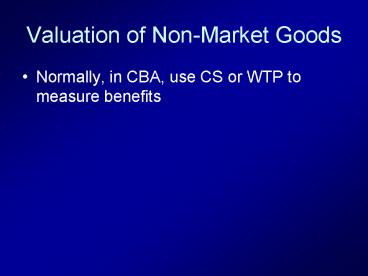Valuation of Non-Market Goods PowerPoint PPT Presentation
Title: Valuation of Non-Market Goods
1
Valuation of Non-Market Goods
- Normally, in CBA, use CS or WTP to measure
benefits
2
?CS - if market price exists
P
?CS P0abP1
P0
a
b
P1
D
Q
3
? WTP - if no market exists (price 0)
P
?WP Q0abQ1
a
b
D
Qo
Q1
Q
4
Valuation of Non-Market Goods
- What to do if a project provides a good or
service for which there is no market? - No market price
- No market demand curve
- Cannot measure changes in WTP or CS
5
Valuation of Non-Market Goods
- A number of CBA techniques have been developed to
estimate WTP for non-marketed goods and services - Revealed Preference Methods Boardman et al.,
Chapter 13 - See also Zerbe Dively, Chapter 18
6
Valuation of Non-Market Goods
- Some techniques
- Markets for substitute goods (analogous goods)
- Hedonic pricing
- Cost savings and intermediate goods
- Travel Cost
7
Substitutes
- Public sector provides a good or service that is
identical to what is provided by private sector - Housing
- Medical services
- Schools
8
Substitutes
- But what if the project is not providing a good
or service that is not identical (not a perfect
substitute) of what private market provides? - E.g. public housing is low-cost housing in areas
with lower property values. - Use hedonic pricing technique
9
Hedonic Pricing
- View demand as implicit demand for a bundle of
implicit characteristics that are bound together
within a good or service - Price of house f(BR, Sq. ft, lot size, school
quality, distance to shopping areas, noise level,
crime rate, ..) - Collect information from a sample of households
with different characteristics of these
characteristics
10
Hedonic Pricing
- Regression model
- House price a b0(BR) b1(Sq. Ft) b2(lot
size) . . . - Then the estimated coefficients represent the
marginal value of the individual characteristics
in the prices of the house. - ? House price / ? BR b0
11
Hedonic Pricing
- With this information can estimate the value of
houses with particular characteristics, in
particular locations. - Projects may also change some of the individual
characteristics, and the estimated coefficients
can be used to value project outputs - Estimate the amount that reducing noise level in
neighborhood around airport will increase home
values in the neighborhood.
12
Intermediate goods (inputs)
- Theoretically, can use derived demand curve
(market demand for the input) to measure changes
in WTP, CS - Often there is not an existing market for the
input - If the project is providing the input for the
first time
13
Intermediate Goods
- Estimate
- Income with project Income without project
- Example impact of irrigation project
- Estimate farmers income with irrigation water
with income without irrigation - Higher yields, changed cropping patterns
- Before/after comparisons
- Returns from farmers in existing irrigated
regions - In both cases, problem of attributing measured
differences to only the availability of
irrigation water
14
Intermediate Goods
- In this simple example, assume constant marginal
product of water. - Do not measure the incremental profit from each
additional unit of water available - Reasonable assumption for small projects,
possible less reasonable for large projects
15
Travel Cost
- Often used to measure the value of recreational
sites - Users must travel to get to site
- This travel is part of the price of using the
site - Different users have different travel costs, and
so pay different prices - Assume all consumers (users) have same
preferences, - Then differences in the observed use levels
(visits) can be associated with different
prices to estimate WTP of the representative
consumer
16
Travel Cost
D
Recreation site
X
A
B
C
D
E
17
Travel Cost
Zone Popula-tion Travel cost / person visits / person CS / person CS / zone (000) trips / zone (000)
A 10,000 20 15 525 5,250 150
B 10,000 30 13 390 3,900 130
C 20,000 65 6 75 1,500 120
D 10,000 80 3 15 150 30
E 10,000 90 1 0 0 10
Total 60,000 10,800 440
18
Travel Cost
- From this information can derive market demand
curve - Spreadsheet
19
Travel Cost
- At price of 95, demand is zero
- Now suppose a user fee of 10 is implemented
- Costs in all zones increase by 10
- 13 visits/person zone A
- 11 visits/person zone B
- 4 visits/person zone C
- 1 visit/person zone D
- 0 visits/person zone E
20
Travel Cost
Zone Popula-tion Travel cost / person visits / person CS / person CS / zone (000) trips / zone (000)
A 10,000 20 15 525 5,250 150
B 10,000 30 13 390 3,900 130
C 20,000 65 6 75 1,500 120
D 10,000 80 3 15 150 30
E 10,000 90 1 0 0 10
Total 60,000 10,800 440
21
Travel Cost
With Use Charge of 10/person
Zone Popula-tion Travel cost / person visits / person CS / person CS / zone (000) trips / zone (000)
A 10,000 30 13 390 3,900 130
B 10,000 40 11 275 2,750 110
C 20,000 75 4 30 600 80
D 10,000 90 1 0 0 0
E 10,000 100 0 0 0 0
Total 60,000 7,250 320
22
Travel Cost
- Consumer surplus without user charge
- 10,800,000
- Consumer surplus with user charge
- 7,250,000
- Change in Consumer Surplus
- -3,550,000
- Revenues from user fee
- 320,00010
- 3,200,0000

